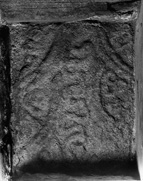Select a site alphabetically from the choices shown in the box below. Alternatively, browse sculptural examples using the Forward/Back buttons.
Chapters for this volume, along with copies of original in-text images, are available here.
Object type: Part of cross-shaft
Measurements: H. 35.5 cm (14 in); W. 43 cm (17 in); D. Built in
Stone type: Coarse-grained, micaceous yellow sandstone (Carboniferous)
Plate numbers in printed volume: 532
Corpus volume reference: Vol 2 p. 142-143
(There may be more views or larger images available for this item. Click on the thumbnail image to view.)
A? (broad): Two parallel rows of stopped-plait interspersed with pellets, triskeles, and star forms flank a central run of single-branch spiral-scroll which has attendant detached foliate forms.
This circle-head is closely linked to an example from Bromfield (no. 2) with which it shares an identical squarish collared shaft along with an ornamental scheme which placed contoured ribbon animals on the broad raised collars and allocated ring-chain to panels on the narrow faces. Like Bromfield's animals, the beasts at Rockcliffe reflect the Jellinge style.
The manner in which the border moulding of one arm on face C overruns the circle is paralleled among the Chester group of circle-heads at Neston (Allen 1895, 170) and is another example of the interpenetration of motifs between the two circle-head groups, which perhaps implies that the Chester and Cumbrian crosses are contemporary with each other (Bailey 1980, 180). A similar phenomenon does, however, occur in the Isle of Man (Kermode 1907, no. 59). Uniquely among the Cumbrian circle-heads the arm-pits of this cross are not pierced but occupied by bosses, which are ornamented with drilled holes. Circle-heads in Cheshire and north Wales have bosses placed in the arm-pits in a manner which, at first sight, closely resembles Rockcliffe (Bu'lock 1958) and one of them even carries a drilled hole (Nash-Williams 1950, no. 190). But in all cases the Cheshire group have the boss set close against the central part of the head and not in the middle of the gap between the circle and the centre. It is probably more relevant, therefore, to remark that bossing of the Rockcliffe type does occur across the Solway in the Whithorn area on freestanding crosses (Collingwood 1922–3, pls. VII, VIII, XI) and that Rockcliffe was, in later medieval times, a point of embarcation for south-west Scotland (McIntire 1939). Some form of contact across the Solway seems the most likely explanation for this peculiar feature.
The animal forms and the Borre-derived ring-chain point to a tenth-century date.
Spiral-scroll school (Introduction, pp. 33–8). The ornamental layout is closely paralleled on St Bees 4 and Unknown Provenance 1, and may also have been used on Beckermet St Bridget 2.



